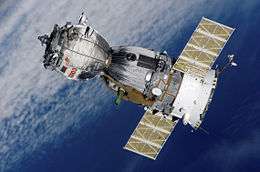Kosmos 186 and Kosmos 188
.jpg)
Kosmos 186 (Russian: Космос-186 meaning Cosmos 186) and Kosmos 188 (respectively, Cosmos 188) were two unmanned Soviet Union spacecraft that incorporated a Soyuz programme descent module for landing scientific instruments and test objects.
Mission
The two Soviet spacecraft made the first fully automated space docking in the history of space exploration on October 30, 1967. Mutual search, approach, mooring, and docking were automatically performed by the IGLA-system on board Kosmos 186. After 3.5 hours of joint flight, the satellites parted on a command sent from the earth and continued to orbit separately. Officially, both made a soft landing in a predetermined region of the Soviet Union - Kosmos 186 on October 31, 1967 and Kosmos 188 on November 2, 1967. According to Boris Chertok "one of the vehicles was destroyed by the emergency destruction system" (See B.Chertok, Rockets and People, Vol.IV, Chapter 8, page 156).
Because of the lethal outcome of both the Soyuz 1 and the US Apollo 1 missions earlier that year it was decided to proceed with unmanned flights first. But because the Soviet Union had no ground stations outside its own territory, this meant the docking had to be done fully automated. After the first attempt failed (a fly-by at a distance of 900 m), the second attempt succeeded over the South Atlantic. However, this docking was not entirely successful either - the modules were mechanically docked, but not electrically. Also, the manoeuvre had cost more fuel than anticipated.
This mission proved it possible to launch smaller parts and assemble them in space, thus eliminating the need for exceedingly large rockets for larger undertakings like a space station.
| Mission | Kosmos 186 | Kosmos 188 |
| Spacecraft | Soyuz 7K-OK (A) | Soyuz 7K-OK(P) |
| Mass | 6,530 kg | 6,530 kg |
| Crew | None | None |
| Launched | 27 October 1967, 09:30:00 UTC Baikonur Site 31 | 30 October 1967, 08:09:00 UTC Baikonur Site 1 |
| Landed | 31 October 1967, 08:20 UTC | 2 November 1967, 09:10 UTC |
| Flight duration | 3 days, 22 h, 50 min | 3 days, 1 h, 1 min |
| Perigee | 172 km | 180 km |
| Apogee | 212 km | 247 km |
| Inclination | 51.7° | 51.7° |
| Period | 88.7 minutes | 89.0 minutes |
| NSSDC ID | 1967-105A | 1967-107A |
